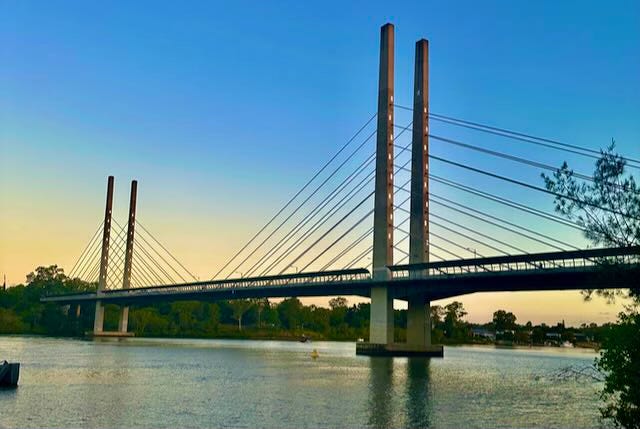A quick trip around SE Queensland
Join me for this quick trip around public transport developments in the Southeast of the Sunshine State as it gears up to host the Olympic and Paralympic Games in 2032.
South East Queensland - made up of the Brisbane metropolitan area, the Sunshine Coast and the Gold Coast (along with rural areas of Scenic Rim, Somerset and Lockyer Valley) - is seriously big. It covers around 35,000 square kilometres and has four million people, making it one of the largest public transport service areas on the planet.
The spines of its public transport network are the rail and busway networks. The fully electrified rail network is extensive, clocking in at 689 kilometres across 12 lines, with a top speed of 140km/h. It extends 260 kilometres from Gympie in the north to the southern Gold Coast in the south. This is complemented by a much shorter but very intensely used busway network - South East, Eastern and Northern - spanning approximately 30 kilometres.
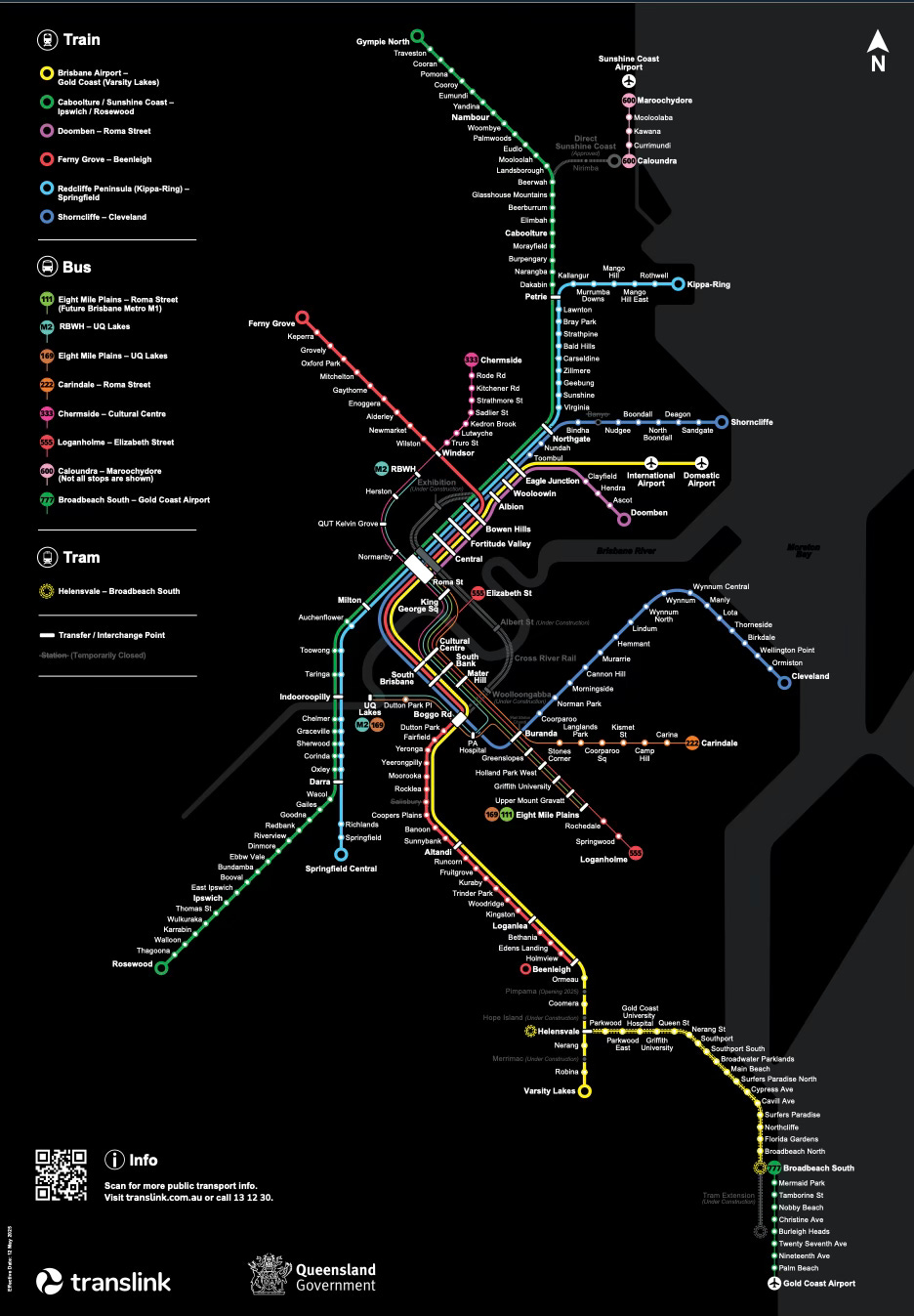
So let’s start at the top with the biggest project of them all: Cross River Rail.
Cross River Rail
Auckland has City Rail Link, Melbourne has the Metro tunnel, Sydney has a whole bunch of metros and South East Queensland has Cross River Rail. Like the other projects, Cross River Rail has similar aims - to improve access to the urban core, to provide additional city centre rail capacity, untangle the rail network and deliver benefits across the whole of SE Queensland.
Cross River Rail consists of a new 10.2 km line through Brisbane City Centre from Dutton Park in the south to Bowen Hills in the north. It includes 5.9 km of twin tunnels and delivers four new underground stations at Boggo Road, Woolloongabba, Albert Street and Roma Street with the existing Exhibition station upgraded.
It provides for 24 trains per hour/ direction and increases the number of tracks through Brisbane city centre from the current four to six. It also provides direct rail access for the first time to the southern part of the city centre, home to state government offices, the Queensland Parliament, the Queens Wharf development and the Queensland University of Technology Gardens campus.
It also introduces European Train Control System level 2 to parts of the network and involves work on train stabling at Clapham and Mayne yards. At this stage, opening is set for 2029.
SEQ Rail Connect
One of the most important elements of Cross River Rail is that it enables sectorisation of the rail network into three independent sectors, meaning that any disruptions on one sector of the rail network won’t cascade through to the other sectors. On top of this, the network will be subdivided into two service types: Suburban turn up and go (for example, Shorncliffe and Ferny Grove lines) and long distance express (for example, the Gold Coast and Sunshine Coast lines). This aims to deliver frequent service at most times for the Brisbane metropolitan area and limited stops express services for the long distance lines.
SEQ Rail Connect provides more detail on plans for the South East Queensland rail network. I recommend reading this for a deeper dive than this post can provide.
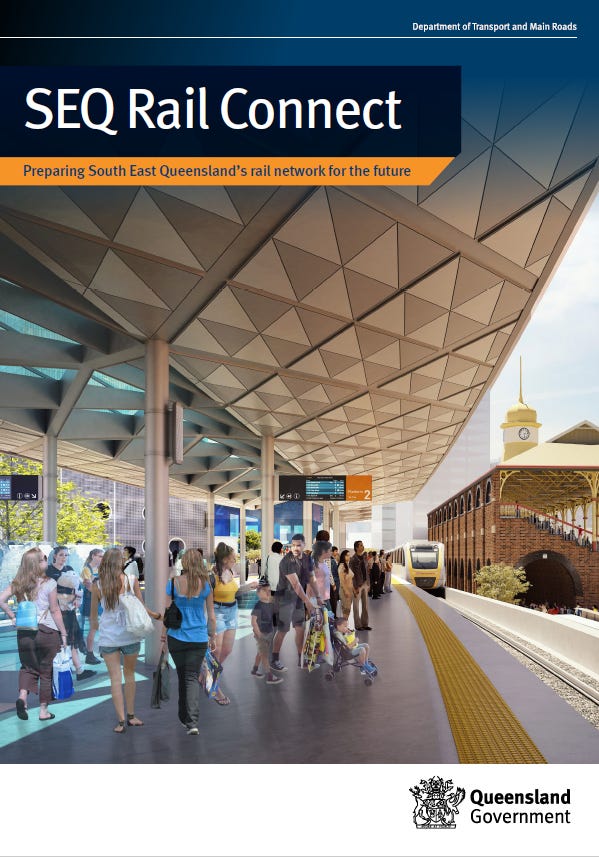
Sunshine Coast Rail
One of the many other big projects in South East Queensland is a major extension of the rail network into the coastal Sunshine Coast, one of the fastest growing regions in Australia with nearly 400,000 residents and nearly four million annual visitors. This project is made up of four stages:
Beerburrum to Beerwah double-tracking
This involves double tracking and straightening a 14-kilometre section of the North Coast rail line, which is an essential pre-requisite to subsequent stages of the project. It is currently underway and expected to be complete in 2027.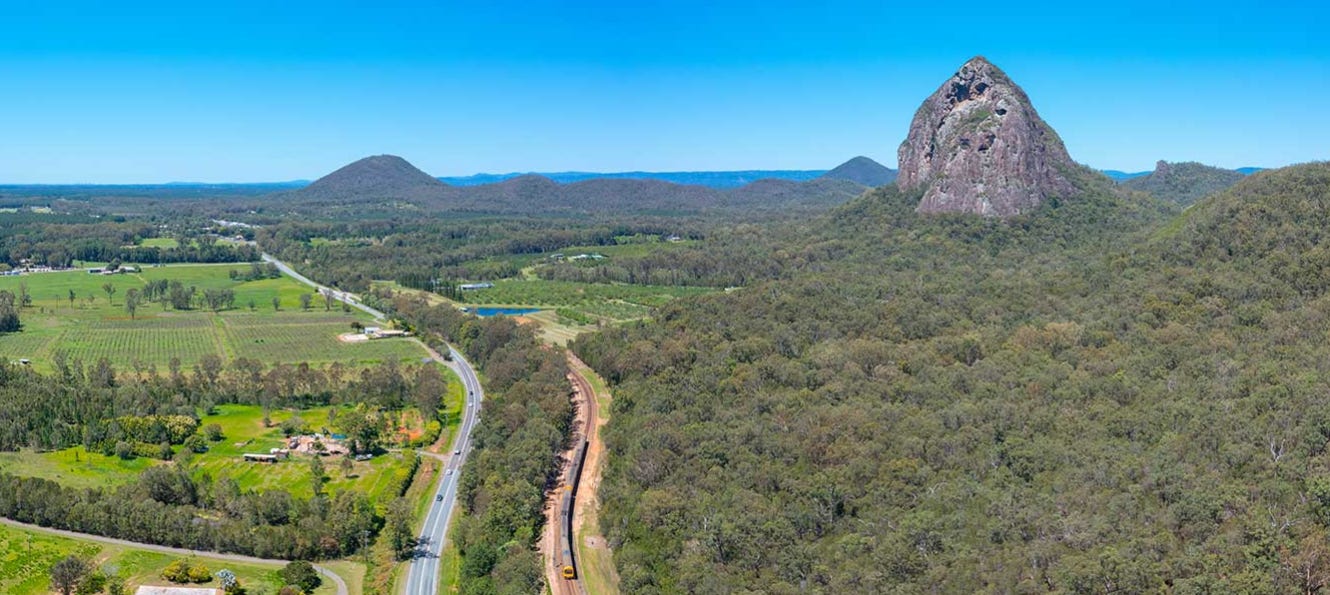
Single-track section of the North Coast line at Glasshouse Mountains, currently being duplicated. Credit: Department of Transport and Main Roads, CC BY 4.0 Sunshine Coast Direct Line stage 1 (aka The Wave 1):
This involves 19 kilometres of dual-track greenfields railway from the current North Coast Line at Beerwah to Caloundra on the southern Sunshine Coast, including the upgrade of Beerwah Station and a new intermediate station in Aura Town Centre in Stockland’s Aura development.Sunshine Coast Direct Line stage 2 (aka the Wave 2):
This extends the Sunshine Coast Line from Caloundra to Birtinya with an intermediate station at Aroona, including a 650 metre tunnel at Little Mountain.Sunshine Coast Metro (aka Wave 3):
A bus rapid transit route from the terminus of the rail line at Birtinya to Sunshine Coast Airport with intermediate stations at Mountain Creek and Maroochydore City Centre.
The rail line is designed for speeds of up to 160km/h while the Bus Rapid Transit route will be an express route on dedicated infrastructure with vehicles similar to the Brisbane Metro vehicle (and more on Brisbane Metro later).

Brisbane’s Busways
Brisbane already has an extensive, and intensively used, busway network made up of three corridors:
Southeast Busway: The original busway, it opened to Woolloongabba in 2000 and Eight Mile Plains in 2001 and was most recently extended to Springwood, with an intermediate station in Rochedale, in 2025. It was the inspiration of Auckland’s Northern Buway and like that busway it parallels a motorway for much of its length.
Northern Busway: This is made up of two disconnected sections of busway. The first second from Roma Street in the city centre to the Royal Brisbane and Women’s Hospital and the second from Windsor to Kedron Brook, with a missing middle section on Lutwyche Road in Windsor.
Eastern Busway: This is in effect two busway sections. One section runs westward from the Southeast Busway to the University of Queensland St Lucia Campus, including the spectacular Eleanor Schonell green bridge (for buses and active modes only) across the Brisbane River. The other section runs eastwards from the Southeast Busway with two stations at Stones Corner and Langlands Park.
The Southeast and Northern busways are linked by tunnels and two underground bus stations in Brisbane City Centre.
Unlike Auckland’s Northern Busway, which runs on a fairly pure trunk-feeder model, Brisbane’s busways are an open system where buses can and do enter and exit the busways at many points, which is especially the case for the Southeast Busway.
According to Wikipedia, as far back as 2007, “In peak hour, 294 buses per hour (one way) (1 every 12 seconds) passed the busway network's busiest point (a section of the South East Busway north of Woolloongabba station).1”
These high volumes means that the busways have become a victim of their own success. This is where Brisbane Metro and Brisbane’s New Bus Network come into the picture.
Brisbane Metro
While Brisbane already clearly has Bus Rapid Transit, its success means that it needs Bus Rapid Transit Max, which is what Brisbane Metro is designed to deliver.
It upgrades the busiest busway routes, routes 66 and 111, with two Metro services, run by bi-articulated battery electric buses. The two routes are:
M1 from Eight Mile Plains to Roma Street Busway Station in Brisbane City Centre via the South East Busway. This service launched on 30 June 2025.
M2 from University of Queensland St Lucia to Royal Brisbane and Women’s Hospital via the Eastern, Southeast and Inner Northern busways. This service launched on 28 January 2025.
These services run every 5 minutes all day, every day of the week; every 10-15 minutes in the evenings; and 24 hours a day from Friday to Sunday with the plan to improve frequency to as often as every 3 minutes once the Adelaide Street tunnel is complete.
This is supported by a range of infrastructure and service improvements, including:
A new bus tunnel linking Victoria Bridge to the City Hall/ King George Square busway station, thereby maximising the capacity of the Queen Street Bus Station.
Platform lengthening and a new platform 3 for West End services at the Cultural Centre Busway Station.
Platform and approach lengthening at Buranda Busway Station.
Flash charging at each of the terminus stations.
The Metro vehicles themselves, fully accessible battery electric bi-articulated buses, able to carry 150 passengers each (or 3,000 per hour/ direction at 3 minute frequency) or 170 passengers each in “event mode.”
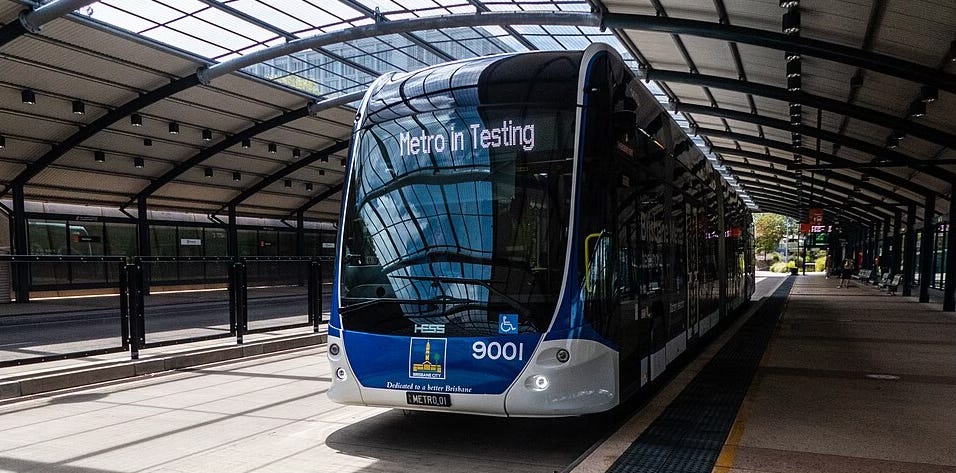
While the Metro services provide the spine of the network, their implementation is accompanied by the Brisbane New Bus Network, which launched on 30 June 2025. This simplified the bus network on the southside of Brisbane and moved it towards a connective network. It also provided new weekday frequent service on corridors like Logan Road and Cavendish Road, and better bus service to the southern part of the city centre, connecting this area by bus to Fortitude Valley. By doing this, it relieved congestion on the inner sections of the Southeast Busway, thereby facilitating the Metro and frequent all-day services on the busway.
Gold Coast and Logan Faster Rail
Rail access to the Gold Coast was re-established after an absence of 35 years with the opening of the Gold Coast Line in 1996 to Helensvale, with extensions to Nerang in 1997, Robina in 1998 and Varsity Lakes in 2009. From being a relatively recent greenfields railway, it has quickly grown to become of the busiest lines in the Southeast Queensland rail network. Demand will only grow with the construction of three infills stations in the fast-growing northern Gold Coast at Pimpana, Hope Island and Merrimac, all due to open in the next two years.
For the first 40 kilometres from Brisbane City Centre, the Gold Coast Line shares tracks with the Beenleigh Line. This shared line is triplicated as far as Kuraby but the 20 kilometre section between Kuraby and Beenleigh is only double-tracked, significantly reducing frequencies on both the all-stops Beenleigh Line and the express Gold Coast Line trains with which it shares tracks.
The Gold Coast and Logan Faster Rail project addresses this by quadruplicating this 20 kilometre section, including track realignment and straightening on slower sections of tracks and the upgrade of all of the stations in this section. In addition, five levels crossings will be grade separated.
Gold Coast Light Rail
The Gold Coast is Australia’s sixth largest city with 640,778 people at the 2021 Census (ABS 2022), 7.9 per cent of whom were born in New Zealand. It is also one of Australia’s fastest growing cities with growth concentrated in a narrow coastal corridor. The first stage of Gold Coast Light Rail opened between Gold Coast University Hospital and Broadbeach South in 2014. It was extended north to Helensvale, where it connects to the Gold Coast heavy rail line to Brisbane, in 2018 in time for the Gold Coast to host the Commonwealth Games that year.
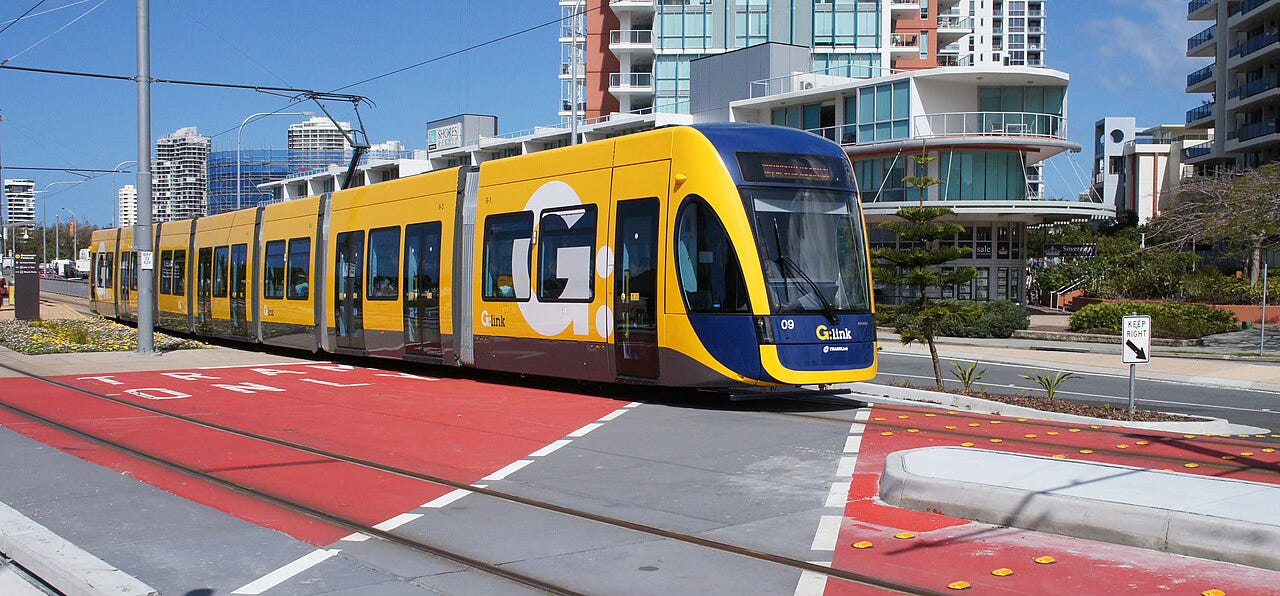
Light rail has been a phenomenal success. In its first year of operation, it carried 6.28 million passengers and public transport patronage on the Gold Coast (tram and bus) increased by 25 per cent2. Tram patronage has since increased by 79 per cent to 11.21 million in the 2023/2024 financial year3 and it was the first public transport mode in SE Queensland to have higher than pre-pandemic patronage.
It is currently being extended a further 6.8 kilometres south to Burleigh Heads with eight new stations. This extension is due to open in 2026 and, at the time of writing, 50 per cent of the track for the extension had already been laid.
New rolling stock
In response to organic patronage growth and as part of preparations for hosting the 2032 Olympic and Paralympic Games, the Queensland Train Manufacturing Program is manufacturing 65 new six-car train sets designed to be world leaders in accessibility. The trains will be built at a purpose-built manufacturing facility in Torbanlea, north of Maryborough and stabled at Ormeau in the northern Gold Coast.
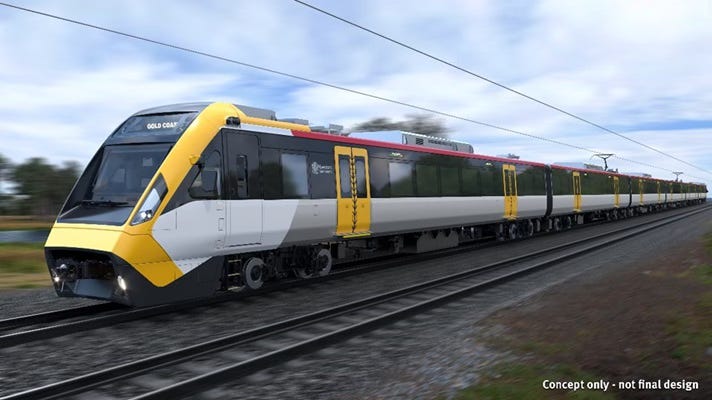
But wait, there’s more
On top of this there is a programme of bus service improvements in Ipswich and Logan in outer metropolitan Brisbane as well as a rolling programme of full rail station accessibility upgrades, including seven being done as part of Cross River Rail. Smart ticketing, enabling use of debit and credit cards and mobile phone wallets, has just this year completed its rollout on all Southeast Queensland public transport.
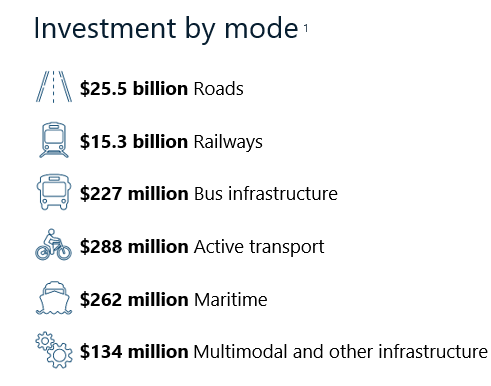
As you can see from the graphic above, there’s quite an ambitious public transport programme underway in Southeast Queensland. The public transport infrastructure investment makes up 37 per cent of the state’s transport infrastructure spend. So worth keeping the Sunshine State on your public transport radar.
South East Busway, Wikipedia in English, accessed on 20 June 2025
Gold Coast Light Rail, Wikipedia in English, accessed on 15 July 2025




